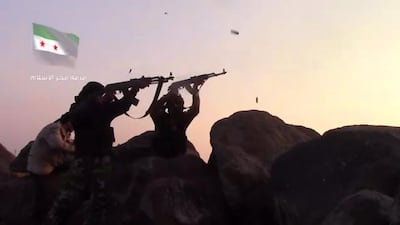Amman // ISIL militants set up sleeper cells, infiltrated rebel communications and exploited corruption and low morale among their moderate opponents to launch a recent successful lightning offensive in southern Syria.
The Khaled Bin Waleed Army, an affiliate of ISIL, was able to seize a strategically important military position, Tal Jamoa’a, as well as key surrounding villages in just a few hours after midnight on February 19, breaking out of what was supposed to be a tight rebel siege.
Details of those critical hours of darkness on the night of February 19 and morning of February 20, recounted by moderate rebels, paint a picture of ISIL as cunning, creative, fast-moving and risk-taking, as well as utterly ruthless.
In contrast, their opponents in moderate rebel factions were easily confused, too quick to retreat and, in some cases, willing to betray their own side.
A clever piece of deception lay at the heart of the capture of Tal Jamoa’a. The Khaled Bin Waleed Army hacked into moderate rebel communications and, posing as moderate commanders, announced that rebel lines had been breached in Heit, Sahem Al Joulan and Tseel, rebel-held villages abutting the Yarmouk basin, where the Khaled Bin Waleed Army has its stronghold.
They told rebel units to retreat because ISIL had already overrun the villages. In fact, they had not.
Simultaneously, ISIL sympathisers in rebel-held territory took control of the public address systems on village mosques and announced that ISIL was in control.
Moderate rebel units fled their positions, believing ISIL had outflanked them and was ready to attack them from behind.
The Khaled Bin Waleed Army had managed to get a handful of fighters behind rebel lines which, in the chaos of the moment, convinced moderates that the breach had, indeed, happened.
The fighters behind them were actually members of ISIL sleeper cells, units that had been secretly formed in rebel-held territory in advance of the attack.
They only revealed themselves at the same time as the faked radio announcement, and began to assault moderate positions from the rear.
Rebel commanders say they believe the ISIL units numbered perhaps ten men in each village — not enough to defeat rebels in an open fight, but enough to spread mayhem and create the impression of a much larger force.
In the chaos, moderate factions had little time to establish just how small and fragmented the ISIL units behind them really were and, rather than stick to their posts and risk capture, many opted to withdraw.
Some rebels did stand and fight, killing some of the ISIL attack force. Numbers remain hard to verify, but 18 moderate rebels were killed in the first hours of the attack, together with nine ISIL fighters. Within 48 hours, 110 people had been killed, most of them moderate rebels. Some rebel fighters, taken prisoner, were beheaded.
The first village ISIL took in the assault was Heit, before quickly advancing into Sahem Al Joulan, then Tseel.
“Sahem Al Joulan and Tseel were easily captured. ISIL knew the Free Syrian Army [moderate rebels] were weak, had been infiltrated and were, unfortunately, cowards,” said a senior rebel with knowledge of the attacks.
In Tseel, a village overlooked by Tal Jamoa’a, ISIL units dressed in uniforms used by moderate rebels commandeered three vehicles also used by moderates and drove up to the communication post.
Communication equipment was spread across Tal Jamoa’a in small, isolated areas. There were 15 posts on the hill, each manned by two to three rebel fighters.
The ISIL fighters advanced through the posts, killing moderate rebels who were too slow to flee.
“ISIL had enough fighters in its sleeper cells to carry out the attack and to cut our supply lines during the night, said Colonel Nijm Abu Al Majd, a moderate rebel commander who was put in charge of the counter attack.
“Their attack was well prepared and they had collaborators who facilitated the operation. Among them were Free Syrian Army [moderate rebels] fighters, who provided services for them.”
A major concern for rebels is the extent to which ISIL managed to recruit supporters. According to Col Al Majd, municipal employees, women and children as young as 12 had been part of the attack, helping to smuggle weapons and materiel through the rebel siege to supply the ISIL sleeper cells.
Another rebel source said there were indications that members of three moderate rebel factions had secretly supplied ISIL with intelligence and ammunition.
The rebel source said the materiel — sold by moderates to ISIL for large sums of money — may have been drawn from supplies handed to rebels by the secretive Military Operations Command, or MOC, in Amman, staffed by Western and Arab army and intelligence officers.
Rebels are currently investigating to see if they were betrayed on such a large scale from within their ranks.
Since the Khaled Bin Waleed Army takeover of Tal Al Jamoa’a, there has been heavy fighting in the area, with control of the disputed villages changing hands almost daily.
On February 26, the MOC summoned moderate rebel commanders. In a two-hour meeting, they reproached them for failing to hold out against ISIL and gave them new supplies of ammunition to bolster their lines.
Supplies from the MOC to moderates flow intermittently and, usually, slowly. In the face of the ISIL assault, the MOC sent supplies the same day.
Within 24 hours, moderate rebels began the operation to take back the villages, under the command of Col Abu Al Majid., and retook large parts of Jileen, and sections of Tal Jamoa’a. The battle continues.
foreign.desk@thenational.ae
*Phil Sands reported from Boston, US, and is an Eric and Wendy Schmidt Fellow at New America

